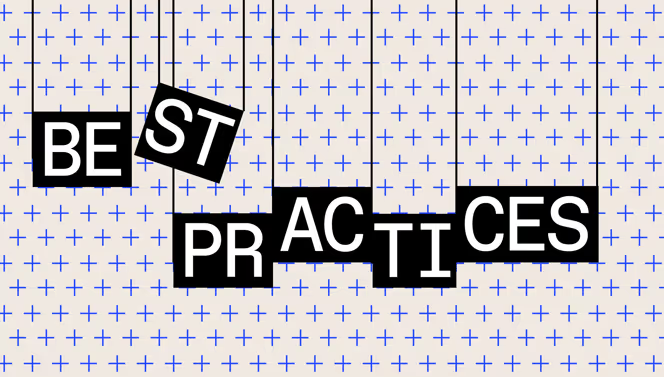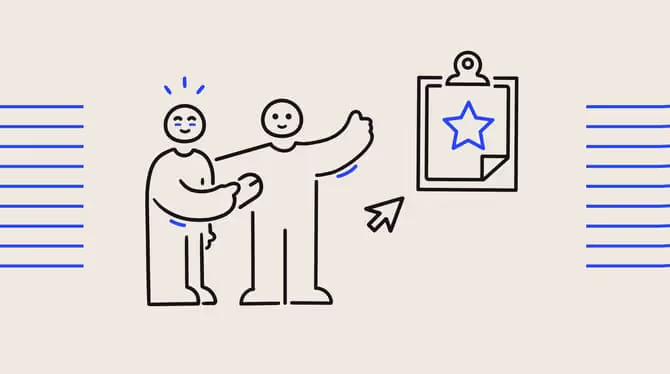Bring out the best in your employees with high-performance management

Discover Workleap Officevibe's benchmark report on 12 key employee engagement metrics

Picture it: your team is at peak performance, operating full tilt in beautiful harmony like a colony of ants in the aftermath of a child’s birthday party. They’re engaged, motivated, focused, and in sync. Now what if we said this could be your team every day?
Well, with high-performance management, it could be. To help get you started, we’ve put together a host of information on what high-performance management is and how to instill a culture of it in your organization. From fostering continuous individual growth to improving teamwork, we’ll show you how a high-performance management system can help you boost employee performance and take your organization to new heights.
What is high-performance management?
Simply put, high-performance management is a turbocharged version of performance management. Where regular performance management involves enhancing overall employee productivity and performance to achieve organizational goals, high-performance management (also known as “top-performance management”) is a more focused approach that works to elevate individual, team, or organizational performance to exceptional levels, creating a culture of excellence within an organization. This is done by measuring, motivating, and developing each team member so that everyone's targets can be exceeded.
Key elements of high-performance management
Although each organization will have its own methods and priorities, there are various consistent elements associated with the implementation of a successful high-performance management system. These include:
- Setting clear expectations and goals: Measuring performance and tracking progress is a million times easier when everyone’s on the same page about what needs to be achieved. To ensure organizational, team, and individual goal alignment, be sure to lay out clear expectations and goals. This will help employees understand what’s expected of them individually and what they’re working toward as a team.
🔎 Searching for a simple, all-in-one tool to define and align individual, team, and organizational objectives? Look no further than Officevibe's easy-to-use goals and OKRs feature.
2. Feedback and recognition: Regular, constructive feedback and recognition play a fundamental role in any successful continuous performance management strategy. By acknowledging achievements, reinforcing positive behavior, and identifying areas for improvement, you’ll enable your employees to develop their skills and improve their performance.
3. Continuous learning and development: Providing opportunities for continuous learning and development empowers employees to supercharge their skill sets and stay on top of ever-changing business needs and trends. Giving employees more autonomy and responsibility also tends to foster ownership, creativity, and innovation.
4. Data-driven decision making: Data and performance metrics can help clearly identify trends that support team growth and success, pinpointing where an employee or team is underperforming and what they’re doing right. Armed with this knowledge, managers can make quicker and more accurate, unbiased, and informed decisions.
5. Good communication: Good communication builds trust between you and your employees — and among team members — enabling smoother collaborations, speedier problem resolutions, and the creation of more innovative ideas. What’s more, effective communication helps ensure that everyone understands their roles and responsibilities, as well as how they can uniquely contribute to the team's success.
Stages of a high-performance management system
The high-performance management system is roughly divided into five stages: assessment, framework development, growth plan customization, providing feedback, and continuous performance management. While these stages aren’t hard and fast, they’re a good guideline to follow when setting out on the journey of crafting high-performance teams.
1. Assess your current company performance
Before embarking on creating your high-performance teams, it's crucial to sit down and thoroughly evaluate your company's current performance so you know what you’re working with.
It's generally best to start by looking at essential aspects, such as financial health, goal achievement, employee satisfaction, communication frequency, employee motivation, and collaboration. You can gather this information through 360-degree feedback, employee surveys, peer feedback reviews, anonymous feedback reports, or scheduling regular one-on-one check-ins. Once collected and collated, this data will help you identify your company’s strengths and areas of improvement.
2. Build a career progression framework
According to a 2021 report by Monster, 45% of surveyed employees said they’d be more likely to stay at their current jobs if they were offered more employee development training. To provide employees with a solid foundation on which to build their careers, it’s essential to design a clear career progression framework that defines roles, expectations, and promotion criteria, tracks an individual’s progress against established goals, and establishes rewards and recognition programs. It also serves as an effective way to maximize their potential and build their confidence, opening the door for greater opportunities within your company.
3. Create customized growth plans for employees
Each employee is a unique individual with their own strengths, weaknesses, and potential for growth — which is why great managers take care to mold their employees’ growth plans to fit their abilities. This is proven in Google’s multiyear research initiative, Project Oxygen, which finds that the best managers are first and foremost effective coaches who tailor their approaches to meet individual skills, aspirations, and development needs.
{highlight}
✂️📐Tip: For best results, tailor your progression framework to individual goals while also aligning them with your company's overall objectives. Easier said than done? Not so! With Officevibe’s AI-powered skill mapping and career development tools, you can track your employees’ development, spot skills gaps, and strategize and implement their career progression plans — all in one place.
{highlight}
4. Use feedback mechanisms
Regular feedback mechanisms, such as one-on-ones, performance reviews, surveys, and 360-degree feedback, are essential to an employee’s continuous growth and improvement. They also facilitate communication between you and your team members, helping to keep your team aligned with company objectives. This helps businesses prioritize employee engagement and overall performance.
{highlight}
⏰ Tip: Implement continuous feedback mechanisms, such as one-on-one meetings and performance reviews, to provide timely feedback and address concerns as they crop up. Implement continuous performance management.
{highlight}
5. Implement continuous performance management
Gone are the days of punitive annual reviews. Instead, companies are adopting a continuous performance management approach that tracks employee performance, highlights their achievements, and identifies their areas of improvement — all on an ongoing basis. This fluid process encourages managers to continuously encourage collaboration, open dialogue, and real-time feedback through regular check-ins and ongoing conversations to ensure goals are on track.
10 Tips to create a culture of high-performance management
An effective performance management strategy is something that needs to be set up and then fed and watered every day. We know this sounds like a bit of work, but it gets easier once you have your processes in place. To help you get there, we’ve come up with some practical tips for creating a high-performance culture in your organization:
1. Instill a sense of purpose/meaningful work
You know how some workplaces are just buzzing with positive, motivated employees who are excited to dive into the deep end of a project and give it their all? Well, all those companies have one thing in common: employees with a strong connection to their organization’s larger purpose.
This makes sense because when your employees know their work isn't just about crossing items off a to-do list but is actually building toward something more meaningful, they’re more driven, engaged, and satisfied. They’re also more open to collaborating with other highly motivated employees, boosting their individual and team performance.
2. Set clear expectations and goals
Setting clear expectations, performance standards, and achievable goals for your employees is the GPS to organizational success. That’s because these factors provide employees with clarity, direction, and confidence. It also keeps them laser-focused on what’s important and creates cohesive collaborations, where teammates work in tandem toward success.
3. Provide regular, constructive feedback
Ongoing feedback is incredibly valuable for both employee development and personal growth. It works to shine a spotlight on your employees’ strengths, areas to improve, and progress toward their goals. This simultaneously boosts their confidence and motivates them to reach for the stars.
That said, feedback should also be timely. That’s because nurturing an employee’s progress right when they need it most helps prevent challenges from snowballing into insurmountable obstacles and keeps their momentum steady.
Finally, feedback is best served constructively. By this, we mean not dwelling on mistakes, but rather highlighting areas where a smidge of polish can make a world of difference.
4. Collect feedback from employees
Embracing a culture of open communication and honest feedback from employees and team members is an invaluable step toward fostering a thriving and dynamic workplace environment. Tuning into colleagues’ experiences and perspectives through surveys and regular one-on-one sessions will give you first-hand information on what's working well and where there’s room for improvement. What’s more, by actively listening and acting on their feedback, you’ll also be showing your employees that you genuinely care about their opinions, fostering trust, belonging, and camaraderie.
🌱 Check out our blog article on how to encourage employee feedback for some fresh ideas on how to harvest valuable feedback from your employees.
5. Recognize and reward both great performance and attitude
Creating a culture of recognition and reward shows employees that their hard work and dedication are noticed and celebrated. But recognition isn’t just a quick pat on the back. Delivering a sincere acknowledgment of a person’s hard work requires you to really look at their work and the value it’s brought to their team and the organization. Doing so will foster an environment of appreciation and inspiration that sparks a contagious cycle of happiness and enthusiasm, which just so happens to be a flammable fuel for igniting greater levels of productivity.
6. Involve employees in decision-making
When you roll out the welcome mat for our team's input, ideas, and perspectives, you’re not just having them follow orders, you’re promoting them to active co-pilots. Empowered by being able to shape future projects and goals, involved employees tend to feel like they're part of something bigger, bringing them greater satisfaction and a greater sense of company loyalty.
But involving employees in decision-making processes shouldn’t just be a one-off thing, it should be woven into the fabric of how you manage, creating a vibrant, engaged, and seriously satisfied community where everyone's voice matters.
7. Coach and mentor your employees
Successfully coaching and mentoring your employees isn’t just about conquering challenges; it's also about fostering growth. To do so, you’ll need to don a lot of hats: a mentor hat, a cheerleader hat, and a trusted ally hat. And you do all this because, by listening to, understanding, guiding, and celebrating your employees, you’re investing in their growth and crafting a team that's not just skilled, but resilient, confident, and ready to reach their full potential.
🎩 Want to be the manager who wears each hat with panache? Check out our tips on how to mentor an employee.
8. Create a culture of continuous learning
A workplace culture of continuous learning motivates employees to seek out knowledge, new skills, and development opportunities they need to reach their full potential in a rapidly evolving job market. But this growth isn’t just beneficial on an individual level; it's also a major contributor to collective success.
That’s because, as employees develop, their teams flourish into powerhouses of diverse skills, talents, and perspectives that feed into, inform, and elevate one another. It’s no wonder managers are employing continuous learning strategies in droves — not to keep up, but to stay ahead of the curve.
9. Have regular conversations on performance, improvement, and growth
Regular performance conversations between managers and employees play a pivotal role in driving productivity, enhancing collaboration, and nurturing individual professional growth. Serving as crucial touchpoints for goal setting, aligning objectives, tracking progress, and fostering a culture of continuous improvement, these structured dialogues are fuelled by frequent, constructive feedback that works to identify challenges, inspire solutions, and encourage employees to reach their full potential.
🤔 Want to introduce regular performance and development discussions but not sure where to start? Our handy guide to one-on-one meetings will teach you everything you need to know and more.
10. Take the pulse on employee engagement
The relationship between employee engagement and performance management is a happily symbiotic one that ultimately works to fuel organizational success. Where employee engagement is more of an emotional commitment that employees have toward their work, performance management involves various processes to evaluate and enhance employee performance.
Monitoring and nurturing employee engagement (through surveys, continuous feedback, and open dialogue) directly influences the effectiveness of your performance management strategy. That’s because, when employees are engaged, they're more likely to be high performers who are motivated, productive, and aligned with organizational goals, which translates to high performance, improved innovation, and overall job satisfaction.
How to build a high-performing team
Building a high-performing team calls for strong leadership skills and the ability to set and stick to clear goals and achievement standards. But there are also some other, more subtle things managers can do to take their team’s performance to new heights. These include:
Building strong team relationships
Establishing strong relationships between your team members ensures smooth collaboration, healthy competition, knowledge-sharing, and enhanced team performance. This can be put down in large part to the trust and respect that grows between employees who have formed a solid bond.
While nurturing this bond among team members can be tricky, especially when some of them are working from home, there are some smart ways to assist your team in making meaningful connections with one another. This includes making time for casual gatherings and encouraging peer coaching, where individuals are paired up with someone who acts as a sounding board and partner.
{highlight}
📖 Discover how to promote trust, unity, respect, and camaraderie among your team members by brushing up on the four main pillars of employee relations.
{highlight}
Encouraging communication
There are countless benefits to effective communication between team members. It lets them quickly identify and resolve issues; promotes a clear understanding of their roles, responsibilities, tasks, and project objectives; and helps keep everyone up to date on each other's progress. It also works to avoid misunderstandings, making everyone feel heard and valued and resulting in fewer conflicts.
You can help create this environment of open, honest communication in your office by encouraging active listening, where team members actively engage in conversations, asking for clarification when needed, empathizing with others’ perspectives, and avoiding interruptions. You can also help create a safe space in which your team can feel comfortable to share their ideas and provide constructive feedback by using digital collaboration tools that allow for asynchronous, anonymous discussions.
Fostering teamwork and collaboration
Fostering an environment of collaboration where everyone can contribute to their team’s overall performance leads to the promotion of shared goals, cooperative problem-solving, and the leveraging of each team member’s strengths and skills. This can create a powerful synergy that leads high-performing teams to innovation, efficiency, and overall improved performance.
Prioritizing diversity and inclusion
Embracing diversity and inclusion within your high-performing team is not only socially responsible, but it also brings substantial benefits to a team's performance, level of innovation, and overall success. That’s because a diverse team provides a pool of ideas, perspectives, and skill sets that help drive overall business performance.
Providing opportunities for individual growth
Individual growth directly translates into overall team progress, so it’s essential to provide your team members with opportunities for career advancement, training and development, and personal growth.
Consider offering professional development opportunities that cater to individual career aspirations and encourage continuous learning. You can also offer personal guidance and mentorship to help team members develop their skills.
Unlocking high performance and a culture of success
High-performance management is a journey that requires commitment, dedication, and continuous improvement. But its rewards are worth the work, as it’s the key to achieving organizational success, enhancing employee satisfaction, fostering personal and career growth, and promoting collaboration and teamwork.
Embrace data-driven decision-making, using digital collaboration tools and feedback mechanisms like Officevibe to make the most informed decisions on how to boost your teammate’s performance.
You’ll also need to provide your employees with continuous training and development opportunities to work on their individual abilities while encouraging strong and healthy inter-team bonds. Book a demo today to learn more about how Officevibe can help your team reach high performance.
Give HR and managers the clarity, confidence, and connection to lead better every day.


%20(1).avif)


.avif)
.avif)








